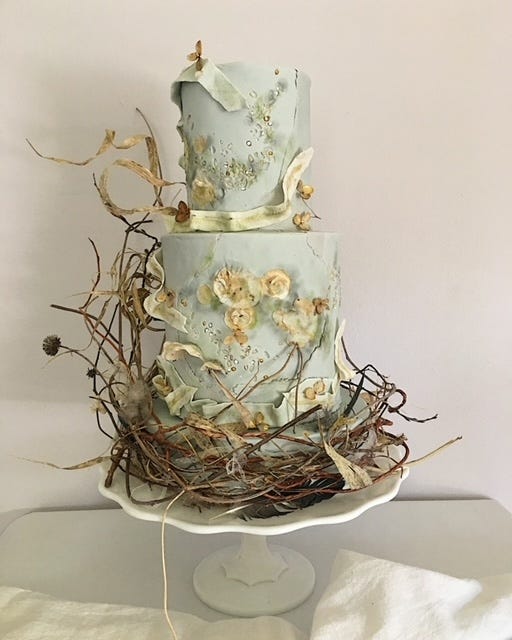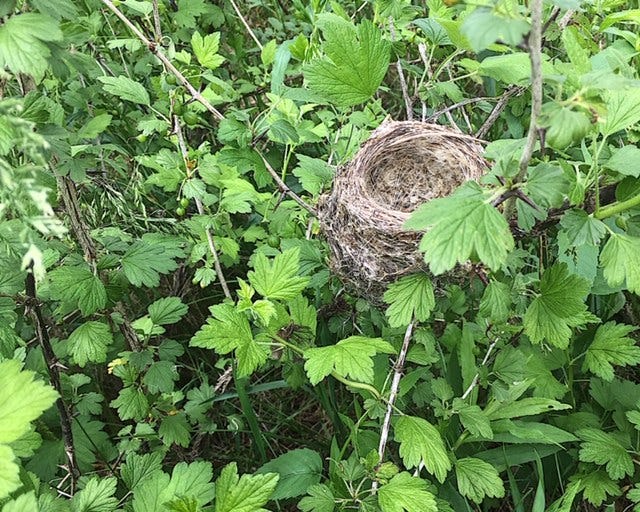Well, it was buried in the Times but headlined on the Marshall Project newsletter: Ahmaud Arbery’s killers were found guilty of federal hate crimes:
“[The jury] gave us the sense of a small victory,” Arbery’s mother said. “But we as a family will never get victory because Ahmaud is gone forever.” After the verdict, U.S. Attorney General Merrick Garland said that no one in America should fear that “when they go out for a run they will be targeted and killed because of the color of their skin.”
I had promised (well, myself mainly) that I would repost at some point, the essay I wrote for my old Curtis & Cake blog as I processed my own grief in the days following Ahmaud’s murder. The wake of this overdue but accurate verdict seems a good time to do so.
***
This is a cake blog. How do you write about grief and sadness, anger and death on a cake blog? Granted, I never wanted to spawn one of those ubiquitous baking blogs. You know these; they follow a gratingly predictable formula. Before you are allowed access to the underwhelming “adapted” recipe—searching for which led you to said blog in the first place—you are obliged to scroll through myriad and multiple photos. The overhead shots of mise en place taken in the pristine light of clear morning, the powdered sugar magically suspended over a bundt mid-dust, the caramel drip dripping just so, the clean cake slice centered on bright white hand-thrown earthen ware. Then seeming pages of pseudo-charming blather. I’d literally rather be reading lorem ipsum space holder text. Certainly I am too old, ornery, and impatient for that approach. But lately, what I’ve been feeling compelled to think and write about is far indeed from the bright studio kitchens of blog world.
All the same, this is a cake blog and I am a cake person. At some point cake became the perfect, generative symbol for things I care about. Things I learned from my mom and other caring creative Black women: connection, celebration, love, hospitality, sustainability, and I guess, yes, grief and anger.
It has made me sluggish in the kitchen but grief has seemed to filter well for me through design. Something about keeping brain, eyes, hands focused on a task but without worry of being beholden to someone else’s occasion. When my mom died in April, my grieving heart went to the kitchen. But it also went to the field. And to the woods where I’d find abandoned nests, bits of fuzz and string still attached. I’d consider how my sadness was, like Pema Chodron suggests in When Things Fall Apart, like a state of being “continually thrown out of the nest.”
I reached for things in the kitchen and woods and fields that reminded me of her and connected me to a line of caring women.—cornmeal, sumac, silvery birch bark, Carolina gold and wild rice, pussy willow. I explored cake decorating techniques that would translate what it felt like to walk with skin pulled back, ribs pried open, and heart vulnerable. It was a funeral cake for the funeral we didn’t get to hold.
a cake designed while grieving my mom
And so it was with Ahmaud Arbery, the pull to design. A funeral cake. A birthday cake for birthdays he’ll never now have. The process of designing it might have been a hymn. A prayer. An offering. A way not to lose it completely. My skin was still raw and tender, my heart already open to this—another mother-child covenant interrupted, permanently altered by death. I fell out of the nest repeatedly learning how to imagine a world without my mom over the course of her 8-year battle with cancer. Ahmaud Arbery was snatched out of his nest. Swiftly. Viciously. Stolen by wolves.
Like Arbery, I too am a runner. I walk at least as much now, if I’m honest—years of tennis have gifted me a grumpy hip. But I have a runner’s spirit, I think, and I owe much of my hard-won sense of well-being to time spent in running shoes. Cardiovascular health is a bonus. I do it for the exhilaration. Being outside, a running thing among other running and flying and buzzing things I feel alive and fleet in a miraculous body. In the woods I’m part squirrel, part magpie, and I always come home with pockets full of beautiful leaves, stones, feathers and thoughts of the wonderous things I saw.
As I mentioned on instagram a while back when I posted a process shot, I wanted to incorporate these things in the design of Arbery’s cake. Things that fill me with wonder like clear creeklets with tiny pebbles sparkling at the bottom, bird feathers, and unidentified mushrooms and fungi. I also wanted to include the abandoned nests I’d spy. They reminded me of the interwoven nature of grief and aliveness. There’s no way to simply pull out the unwanted strands without unraveling the entire project. The bottom tier nest of Arbery’s cake is made entirely of bits of cloth, twigs, rush, and feathers I found in the woods.
vision board for Ahmaud’s cake
I grappled with sharing the cake on insta. I considered how sharing on these platforms always already tries to turn whatever it is into marketing. Into self-promotion or brand work. I thoughts about how sharing it might make me complicit in a violence of reiteration. But I wanted to share. To hug us. To reach out, communicate something. Produce something thoughtful. To share a slice with all my folks in celebration of our creative survival.
a cake designed for Ahmaud Arbery
The urge to make something thoughtful also led to attempts at written things (of which this overly long post is one). There are easily two dozen crumpled up wads of electronic paper in my laptop’s waste bin. A paragraph here, a few pages there… rejected attempts at communicating what? Thoughts? Feelings? Something, in the wake of a murder. A theft. Of course Arbery wasn’t the first. Or the last, In fact, Breonna Taylor was stolen before I had even finished the cake design. In fact, George Floyd was stolen before I finished writing an early version of this piece. And in fact, still more atrocities have occurred since. What could the words possibly be? I can’t keep up. There’s not anything I can write that hasn’t been written, stated, argued, analyzed, pleaded, critiqued across a 500 year American history of violence against black bodies. What could I add that might better or differently communicate the collective rage, deep sadness and sense of loss we feel with each hole punctured in our fabric? The shock of shared trauma that occurs when one of our finely spun golden threads (which we each are) is yanked out mercilessly—shifting askew the bias of our warp and weft? Of our cloth? Our nest?
To be fully alive, fully human, and completely awake is to be continually thrown out of the nest.” —Pema Chödrön
As I shared on Facebook shortly after Arbery’s death, I have been leered at, cat-called, yelled at, and coal rolled when running by the same kind of guys responsible for his murder. Anger and self-righteousness just simmering in their blood. Their deep wounds festering just below consciousness. I don’t run on those roads now. I explained. If I have to be on an exposed road, I face traffic. If I see a certain kind of pick up coming I shift my path several feet away from the road to avoid exhaust, projectiles or worse. I try for a quick commit of license plate numbers just in case. Hackles up or spider sense always engaged. The vigilance is exhausting. A vigilance required, as bell hooks writes in belonging: a culture of place, “in all white settings [like the neighborhood where Ahmaud was murdered. Like the Wisconsin town in which I live.] where it can be assumed, there are many who have not yet unlearned racism . Where there are many who believe still, that it constitutes merely individual acts of brutality or meanness. Who do not understand it as an often invisible web of systems, policies, laws that are reinforced, reiterated, made material and manifest by everyday, on the ground behaviors. (p. 86-87)” A web of systems that creates month-long delays in arrests, and indefinite ones in convictions. A web of systems that engendered a “hospitality” industry who’s essential value so often only seems to be profit above collective wellbeing or comfort. A web of systems that has made us particularly and multiply vulnerable to the novel coronavirus. A web of systems that keeps your subordinates on the force quiet as you wedge your knee into a handcuffed man’s neck for 8 minutes and 46 seconds.
This is a hospitality blog. I didn’t know Ahmaud Arbery and I didn’t know much about his relationship with running. But I know what it’s like to run while Black. And the Black body still knows that some places are inhospitable. The Black body has learned the intimate connection between geography and well-being. The Black body is always—at least partially—out of time and out of place. Several weeks ago I watched a YouTube talk with Fred Moten and Saidiya Hartman theorizing the Black Outdoors. Moten noted that he can’t hike a trail without considering the ghosts of runaways. Hartman’s discussion of the petite marronage brought to mind for me the ‘leave no trace’ principles I learned as a young trail runner.
As I move through the woods on well-worn trails I am always keeping pace with the ghosts of runaways and maroons. I always know that an Amy Cooper might be waiting around the next turn, cell phone in hand. Her unleashed dog calling to mind the bloodhound. Even still. If I’m lucky, on these runs, if my pace is just so, I can become a maroon myself. Just for a few short minutes. In High On the Hog, Jessica B. Harris reminds us that “ the term “maroon” comes from the Spanish word cimarrón, which is defined as “wild savage” and itself comes from the Spanish word cimarra, meaning “wild place.” (p.58) I’m happy to claim that wildness when I have the chance. In the wild places I am right-sized. A wildling. I can behave my self. Light on my feet, I move soundlessly on moss and pine needles. I gain spatial orientation by bird call. When no one’s around, I stop, catch my breath and listen. The lake makes gentle conversation with the shore, jostling lichen covered rocks along its edge. Shagbark hickory branches rustle in the wind. A crow caws in the distance, a fat bumble bee buzzes somewhere near but behind my ear. I feel…free. I feel a part of it all oriented thusly and I gain the resilience to bake another day.
***
Thank you for reading! —Monica








Oh am I ever glad to find you here! Your writing is somerhing that often has me holding my breath. And the grief cakes, of course, too, with each detail. It (yours) is an art form that speaks to all the places we hold lives and life cycles in our bodies and hearts.